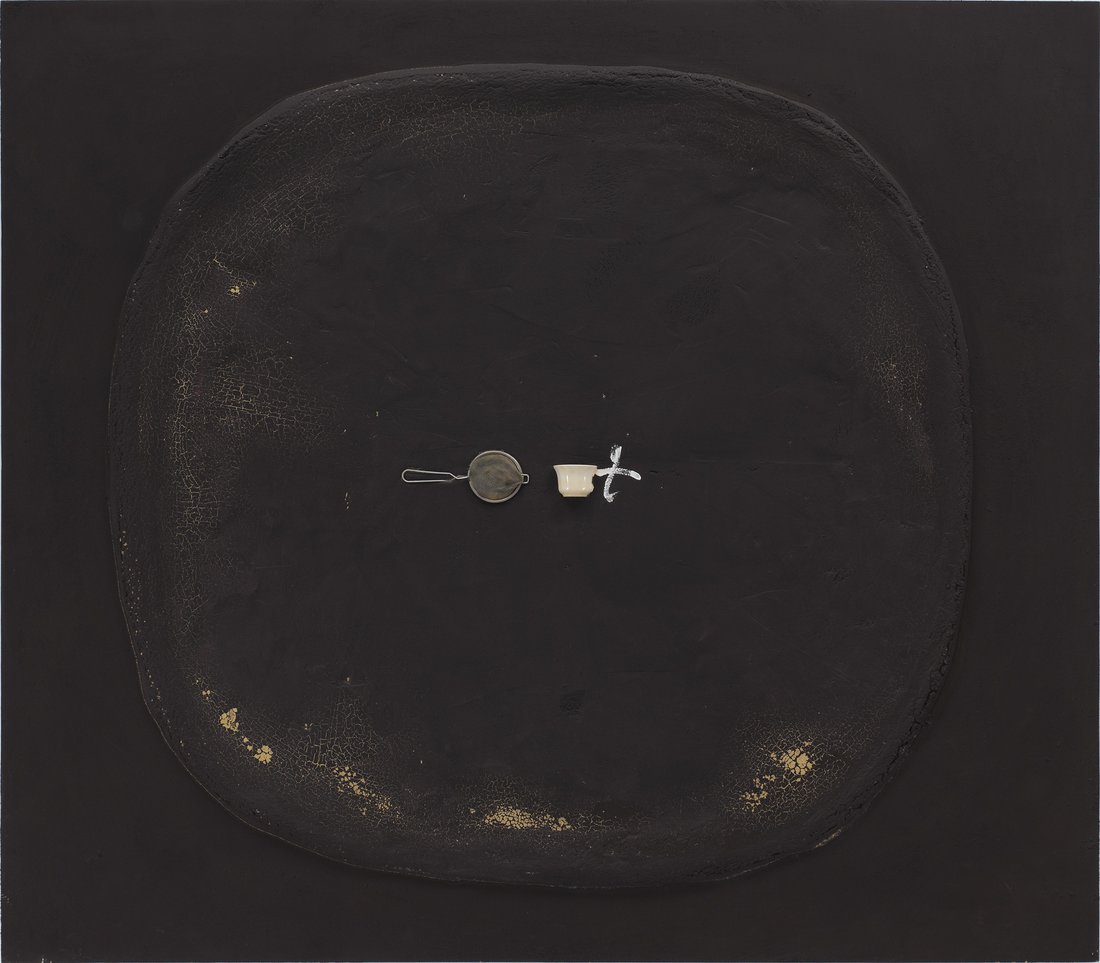PRESENTATION: Antoni Tàpies
 Antoni Tàpies refined a visual language inspired by a wide range of sources that coalesce into a complex fusion of materials, gestures, and symbols. His exploration of Surrealist imagery early in his career served as the foundation for an ongoing investigation into the nature of physical objects and their materiality. Tàpies’ work embodied his extensive personal experience and history of his native Spain and specifically Catalonia. As Tàpies’ use of tangible materials for making art emphasize physical transformation, spiritual transformation is evoked through signs and symbols drawn from Eastern and Western cultures.
Antoni Tàpies refined a visual language inspired by a wide range of sources that coalesce into a complex fusion of materials, gestures, and symbols. His exploration of Surrealist imagery early in his career served as the foundation for an ongoing investigation into the nature of physical objects and their materiality. Tàpies’ work embodied his extensive personal experience and history of his native Spain and specifically Catalonia. As Tàpies’ use of tangible materials for making art emphasize physical transformation, spiritual transformation is evoked through signs and symbols drawn from Eastern and Western cultures.
By Efi Michalarou
Photo: Pace Gallery Archive
The exhibition with works by Antoni Tàpies at Pace Gallery in Geneva, examines his central theme of transformation, both physical and spiritual, which Tàpies explores through the use of signs and symbols. Over nearly 70 years, Tàpies (both artist and influential philosopher of art) created a prolific and singular body of work that redefined painting and the way colors and physicality are manifested through the medium, thereby influencing future generations of artists and fascinating curators and Museums around the world. Works in the exhibition span two decades, ranging in date from 1990 to 2008, and include both paintings and works on paper, highlighting the artist’s constant experimentation with materials. Emblematic of this experimentation is “Colador i Tassa” (1998), a richly textured painting on wood comprised of both conventional painting materials as well as the everyday objects from which the work gets its name: a cup and a tea strainer Tàpies refined a visual language inspired by a wide range of sources that coalesce into a complex fusion of materials, gestures, and symbols originating mainly from his native Catalonia and studies of Eastern and Western spiritual traditions. Symbols such as the “t” may reflect ideas of resistance, mystery and the unknown, or, more simply, may refer to the first letter of the artist’s name. These symbols are prevalent in “Plat blan” (2008), “Signes blaus” (2008), and “Petita sanguine III” (2000) in the exhibition. Ambiguous but powerful, the use of symbols refers to the natural world and the history of painting. Tàpies’s work embodies his personal experience and history, and of his native Spain and Catalonia specifically. “Terra del Montseny” (2008), a painting which celebrates Catalonia’s main mountain massif, incorporates dirt from the land around his country home. While the piece demonstrates Tàpies’s striking handling of raw materials, it also instills a strong sense of mystery, symbolism, and reverence for nature. His investigation of forms and matter made him one of the most influential postwar artists. Antoni Tàpies was born on 13/12/1923, in Barcelona. His adolescence was disrupted by the Spanish Civil War and a serious illness that lasted two years. Tàpies began to study law in Barcelona in 1944 but two years later devoted himself exclusively to art. He was essentially self-taught as a painter; the few art classes he attended left little impression on him. Shortly after becoming an artist, he began attending clandestine meetings of Els Blaus, an iconoclastic group of Catalan artists and writers. They were the precursors to Dau al Set (1948-53), which produced an eponymous review (54 issues, 1948-56). Tàpies’s early work was influenced Max Ernst, Paul Klee, and Joan Miró, and by Eastern philosophy. His art was exhibited for the first time in the controversial Salo d’Octubre, Barcelona, in 1948. He soon developed a recognizable personal style related to matiérisme, or Art Informel, a movement that focused on the materials of art making. The approach resulted in textural richness, but its more important aim was exploring the transformative qualities of matter. In 1950, his first solo show was held at the Galeries Laietanes, Barcelona, and he was included in the Pittsburgh International. The same year, the French government awarded Tàpies a scholarship that enabled him to spend a year in Paris. His first solo show in New York was presented in 1953 at the gallery of Martha Jackson, who arranged for his work to be shown the following year in various galleries around the United States. During the 1950s and 1960s, Tàpies exhibited in major museums and galleries throughout the world. In 1966, he began a collection of writings, “La practica de l’art. In 1969, the book “Frègoli”, a collaboration with poet Joan Brossa, was published; a second joint effort, “Nocturn matinal”, appeared the following year. Tàpies received the Rubens Prize of Siegen, West Germany, in 1972. In the early 1980s, he continued diversifying his mediums, producing his first ceramic sculptures and designing sets for Jacques Dupin’s play “L’Éboulement”. In 1990, the Fundació Antoni Tàpies opened in Barcelona, established in Tàpies’s name to study and exhibit modern and contemporary art, periodically preparing Tàpies-centric exhibitions and publications. In 1993, he and Cristina Iglesias represented Spain at the Venice Biennale, where his installation was awarded the Golden Lion. Tàpies died on 6/2/2012, in Barcelona.
Info: Pace Gallery, Quai des Bergues 15-17, Geneva, Duration: 8/11/19-10/1/20, Days & Hours: Tue-Sat 10:00-18:00, www.pacegallery.com


